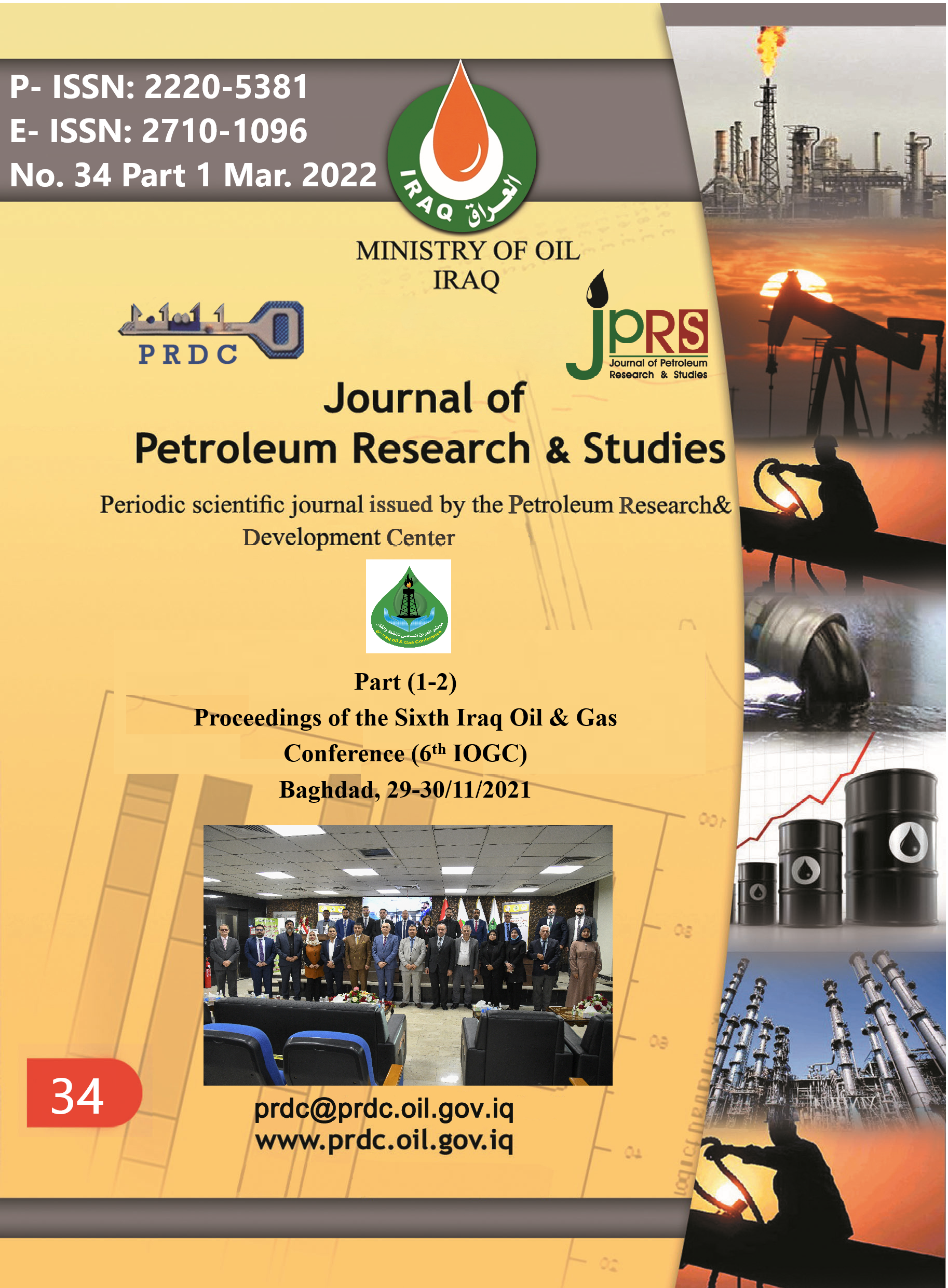Converting Carbon Dioxide in to Methane Gas and Enhance Oil Recovery by using Biotechnology Process
DOI:
https://doi.org/10.52716/jprs.v12i1.601Keywords:
Rumaila field, thermophiles bacteria, Methanogenic bacteria, MEOR, Gas chromatography.Abstract
Using biotechnology in petroleum industry has many advantages .for example , Microbiologically Enhanced Oil Recovery (MEOR) increase of the productivity of the oil field and decrease the viscosity of the crude oil . It's known that atmosphere has considerable amount of CO2 gas as a result of industrial activities (crude oil production). CO2 gas plays a role in increasing atmosphere temperature and causing global warming. Bioremediation is a viable Biotechnology function for Re-producing depleted wells and global warming. It means Bioremediation uses metabolic adaptation of microorganism, a promising approach, using this technique employs of Methanogenic bacteria to convert CO2 gas in to CH4. Therefore turns carbon dioxide in to carbon which is added to crude oil (so contribute decrease the viscosity for heavy crude oil, This mechanism is a part of the promotion of oil production.it is apart an operation EOR. and Second reacts with Hydrogen by Bacteria to produce methane gas. The aim study, advantage this method increase production. and removal global warming. In this review, we discuss the role of Methanogenic bacteria in transforming CO2 gas into methane gas , that it has a role in crude oil production . Methanogenic bacteria have an important role in petroleum industry and environment during decreasing CO2 amount in the atmosphere and increasing reservoir pressure. MEOR technology uses strains that have a role in crude oil production; these bacterial strains produce biogases (Methane) that increase reservoir pressure. In this study, six strains were isolated from Rumaila oilfield, south of Iraq. These strains were identified based on microscopic and morphological observations. These strains were Methanogenic bacteria. The main part of this study includes identification of bacteria that can consume CO2 gas and making continual lab experiments to isolate and determine the best genus to do this process in oil field. Experiments were done in specific bio-labs for two years, Methanogenic bacteria strains were isolated by using specific selective growth media. The second part of this study is using these strains for bioremediation process of oil wells, which includes providing anaerobic conditions for these strains to transform CO2 gas to methane . Morphological and microscopic observations were conducted to these strains and showed the best kind of these strains according to the ability of transformation of CO2 to methane. The isolated bacteria were called BRS11 strain showed high efficiency in transformation of CO2 to methane.
References
Anthony I okoh, “Biodegradation alternative in clean of petroleum hydrocarbon pollutants”, Dep. Biochemistry & Microbiology © university of fart hare, South Africa, 2006.
AB., “Oman eyes Gulfs first coal power plant” by Dayan Canada ppa, available at http://www.arabianbusiness.com, Sunday, 27 January 2008.
Anderson Soren, Newell R, “Prospects for Carbon Capture and Storage Technologies "Discussion Paper 02–68 January 2003.
API, American Petroleum Institute, “Emissions estimating and reporting”, paper presented at the 2nd API Conference on Voluntary actions by the oil and gas industry to address climate change, Houston, Texas, USA, November 2002.
Bach S., “Screening and Ranking of Hydrocarbon Reservoirs for CO2 Storage in the alberta basin”, Canada, 2001.
Yoshiliro Takai, “Bacterial lifestyle in a Deep sea Hydrothermal vent chimney”, Revealed by the Genome Japan agency © Yokosuka Japan, 2010.
Shahaby A. F., “Mobile phone as potential reservoir of bacterial”, Cairo university © Academic Journal, Egypt, 2012.
Fisher, “oil field water and sandstone diagnosis” Dep. Geology and physics© Elsevier. U.S.A., 1987.
Franken Berger W.T., “Relationships between enzyme activities’ and microbial growth and activity indices in the soil”, j. 47: 945 Soil science society of America Journal, 1983.
George V. Chilingarian, “Microbial enhanced oil recovery”,© Erlec Donaldson, U.S.A, 1996.
Header, “Bioremediation of petroleum oil contamination soil and water”, Reresearch Journal of Environmental Toxicology, 5: 1-26 D.P. Jaroli and U.K. Chauhan, 2011.
IPCC,Clean Development Mechanism (CDM),
«http://cdm.unfccc.int/index.html»http://cdm.unfccc.int/index.html
Cédric Philibert, IEA, “ carbon capture and storage”, «http://www.iea.org/text base/papers/2007/CCS_in_CDM.pdf» 2007.
K Riahi, ES Rubin, “Prospects for Carbon Capture and Sequestration technologies”, International Conference, 1095- 1100, 2003.
Jyh – yih Lea, “Bioconversion”, Department of Safety, Taiwan University of Science and Technology, 40601, Taiwan Available online 24 February 2011.
Kyoto. “Protocol to the united nations framework convention on climate change”, December 1997.
Michel Magot, “Microbiology of Petroleum reservoir”, © Kluwer Academic publisher Nether lands 2005.
Noah Youssef, Mostafa, Elshahed and Michael J,Mclnerney, “Advance in Applied Microbiology, Microbial Processes in oil field”, volume 66, Burlington: Academic Press. © Elsevier 2009.
OPEC, “Monthly Oil Market Report”, August 2005.
Paul F. Hoffman, “ Ice _ sheet Dynamic” © Journal of Geology of South Africa, December 2005.
P.D. Shame, “Microbiology”, Restogi Publication Amazon 2011.
Ramsay, H.J. and Small, F.R., “Use of Carbon Dioxide for Water Infectivity Improvement”, Journal of Petroleum Technology, 1964.
Rancher, “Rancher Energy Corporation, EOR overview”, Available at http://www.rancherenergy.com/technology.asp?techID=2..59. 2007.
Rivas, O., Embid, S., and Bolivar, F., “Ranking reservoirs for carbon dioxide flooding processes”, SPE Paper 23641, SPE Advanced Technology Series, v. 2, pp. 95-103, 1994.
Vance and Thrasher, “Microbial response to reinjection of produced water in oil reservoir” ©Springer, 2005.
WEC, World Energy Council, “Carbon Capture and storage”: A WEC interim balance available at (http://www.worldenergy.org/wec-geis/focus/ccs), 2005.
Downloads
Published
How to Cite
Issue
Section
License
Copyright (c) 2022 Abbas Kadhim Ayyed

This work is licensed under a Creative Commons Attribution 4.0 International License.














